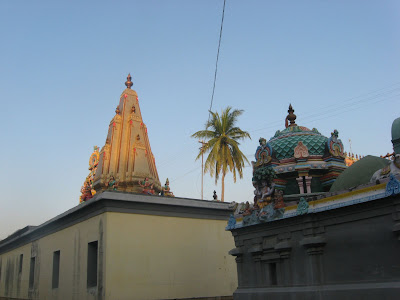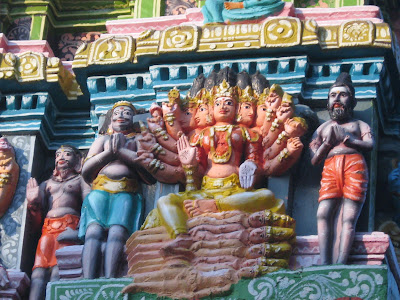Memory is unpredictable . One never really knows what we will remember and what we will forget. Which is why nostalgia arrives in unpredictable waves, highlighting something and skimming over others. Recently, I have found myself thinking of how memory works, as I was assailed by nostalgia over a trip to Varanasi, a city I prefer to think of, as Kashi. The nostalgia hit right as we landed at Varanasi airport. The last time I was here, it was 1988, I was 13 years old, the airport was brand new… regular flights hadn’t started yet (I think) … flights landed about once a week, and for the rest of the time, everything was open to those of us who lived in the airport quarters nearby. There were fields everywhere, vast expanses of green… I have vague memories of corn and sugarcane… and being overwhelmed by the vastness of the fields (this was the first time I was in such close proximity to them), and the warm hospitality of complete strangers who lived and worked amidst these fields. I h...
Every Shiva temples has certain deities. While the central deities are Shiva and Parvati, all Shiva temples have other deities in the Pragaram like Ganesha, Muruga, Dakshinamoorthy, the Navagrahas, and Chandikeswarar. Each of these deities takes his/her place according to the direction/position he/she is assigned. Situated around Kumbakonam is a group of temples whose deities (not necessarily the central one) together form a temple much, much bigger than any temple in existence. The temples are as far apart as Swamimalai and Chidambaram. These temples are collectively called the Parivara Sthalams.
The central temple in this group is Thiruvidaimarudhur.
Thiruvidaimarudhur - Shiva
Thiruvidaimarudhur is situated 8 Kms from Kumbakonam on the Mayiladudurai road, 1 km from Thirubhuvanam. This is a huge temple, with 3 pragarams. It is considered auspicious to circumambulate all the 3 pragarams.
The main deity in the temple is Mahalingeswarar, and his consort is Anbilpiriyar. There is a shrine to Ardhanareeswarar and also one to Mookambigai, which is extremely rare. There are also lingams dedicated to each of the 27 Nakshatras in the inner pragaram of the temple. There is also a fresco of Ravana lifting Kailas, under which is depicted the main deity under the Marudha tree, which is the sthala vriksham – Marudhavaneswarar. This temple also has a Spatika lingam called Uru Vidangar, and the abhishekam to this lingam is performed from 9 - 9:30AM.
It is the norm in this temple that one can enter by any gate, but one must never leave by the main entrance. The reason for this lies in the legend of Varaguna Pandiyan. The king unknowingly ran over a Brahmin, and was afflicted by the Brahma-Hatti Dosham. He came to this temple, and the spirit of the dead Brahmin could not enter along with him. it therefore waited outside the main entrance for him to come back. The king was advised by the lord to leave by the west gate, and thus he escaped the spirit. It is believed that the spirit resides there till date, waiting for someone to exit by the entrance gate, thus afflicting him.
The other Parivara Sthalams are:
Thiruvalanchuzhi – Ganesha
To read about the temple at Thiruvalanchuzhi, click here.
Swamimalai – Muruga
To read about the temple at Swamimalai, click here.
Thirukkadaiyur –Ambigai
To read more about Thirukkadaiyur and Abirami, click here
Alangudi – Dakshinamoorthy
To read more about Alangudi, click here.
Suryanar Kovil – Navagrahas
To read more about Suryanar Kovil, click here.
Thirunallar – Shaneeswarar
To read more about Thirunallar, click here.
Sengalur – Chandikeswarar
Sengalur is considered to be the birthplace of Chandikeswarar. According to the legend, as a young boy, he spent all his time making lingams out of sand and meditating One day, his father got angry and kicked the lingam. The child got angry, and at once cut off his father’s leg, for daring to kick his lord. Shiva appeared from the lingam and blessed the boy, giving him a permanent place in his temple. He also gave his father his leg back. It is believed that Chandikeswarar forever lives in a state of deep meditation, not realizing who comes to the temple. He is the one who keeps records of our visits to the temple, and hence, it is believed that we should clap our hands or snap our fingers outside his shrine so that he realizes our presence.
Sengalur is situated on the Kumbakonam Mayiladudurai road, about an hours drive from Kumbakonam. The temple is quite small, and work was in progress when we visited. The main deity here is Shiva as Thirushakteeswarar.
Sirkazhi – Bhairavar
To read more about the temple at Sirkazhi, click here.
I must add, however, that there is a separate shrine to the Ashta Bhairavars at Sirkazhi, just near the main entrance of the temple.
Chidambaram – Natarajar
Chidambaram is the only temple we did not visit on this trip, though we have been there earlier. Of course, this beautiful temple of Nataraja needs no introduction. Let me wait till I visit the temple again to write a blog about this temple.
Thiruvarur – Somaskandar
To read more about Thiruvarur, click here.
Thiruvavadudurai – Nandi
To read more about Thiruvavadudurai, click here
As I write this, I can’t help imagining what a temple of this size would look like. To begin with, circumambulating such a temple itself would take days! I wonder whose brain it was that came up with such an idea!
The central temple in this group is Thiruvidaimarudhur.
Thiruvidaimarudhur - Shiva
 |
| From Diwali 08 - Thanjvur Trip |
Thiruvidaimarudhur is situated 8 Kms from Kumbakonam on the Mayiladudurai road, 1 km from Thirubhuvanam. This is a huge temple, with 3 pragarams. It is considered auspicious to circumambulate all the 3 pragarams.
 |
| From Diwali 08 - Thanjvur Trip |
The main deity in the temple is Mahalingeswarar, and his consort is Anbilpiriyar. There is a shrine to Ardhanareeswarar and also one to Mookambigai, which is extremely rare. There are also lingams dedicated to each of the 27 Nakshatras in the inner pragaram of the temple. There is also a fresco of Ravana lifting Kailas, under which is depicted the main deity under the Marudha tree, which is the sthala vriksham – Marudhavaneswarar. This temple also has a Spatika lingam called Uru Vidangar, and the abhishekam to this lingam is performed from 9 - 9:30AM.
 |
| From Diwali 08 - Thanjvur Trip |
It is the norm in this temple that one can enter by any gate, but one must never leave by the main entrance. The reason for this lies in the legend of Varaguna Pandiyan. The king unknowingly ran over a Brahmin, and was afflicted by the Brahma-Hatti Dosham. He came to this temple, and the spirit of the dead Brahmin could not enter along with him. it therefore waited outside the main entrance for him to come back. The king was advised by the lord to leave by the west gate, and thus he escaped the spirit. It is believed that the spirit resides there till date, waiting for someone to exit by the entrance gate, thus afflicting him.
 |
| From Diwali 08 - Thanjvur Trip |
 |
| From Diwali 08 - Thanjvur Trip |
 |
| From Diwali 08 - Thanjvur Trip |
The other Parivara Sthalams are:
Thiruvalanchuzhi – Ganesha
To read about the temple at Thiruvalanchuzhi, click here.
Swamimalai – Muruga
To read about the temple at Swamimalai, click here.
Thirukkadaiyur –Ambigai
To read more about Thirukkadaiyur and Abirami, click here
Alangudi – Dakshinamoorthy
To read more about Alangudi, click here.
Suryanar Kovil – Navagrahas
To read more about Suryanar Kovil, click here.
Thirunallar – Shaneeswarar
To read more about Thirunallar, click here.
Sengalur – Chandikeswarar
Sengalur is considered to be the birthplace of Chandikeswarar. According to the legend, as a young boy, he spent all his time making lingams out of sand and meditating One day, his father got angry and kicked the lingam. The child got angry, and at once cut off his father’s leg, for daring to kick his lord. Shiva appeared from the lingam and blessed the boy, giving him a permanent place in his temple. He also gave his father his leg back. It is believed that Chandikeswarar forever lives in a state of deep meditation, not realizing who comes to the temple. He is the one who keeps records of our visits to the temple, and hence, it is believed that we should clap our hands or snap our fingers outside his shrine so that he realizes our presence.
Sengalur is situated on the Kumbakonam Mayiladudurai road, about an hours drive from Kumbakonam. The temple is quite small, and work was in progress when we visited. The main deity here is Shiva as Thirushakteeswarar.
Sirkazhi – Bhairavar
To read more about the temple at Sirkazhi, click here.
I must add, however, that there is a separate shrine to the Ashta Bhairavars at Sirkazhi, just near the main entrance of the temple.
Chidambaram – Natarajar
Chidambaram is the only temple we did not visit on this trip, though we have been there earlier. Of course, this beautiful temple of Nataraja needs no introduction. Let me wait till I visit the temple again to write a blog about this temple.
Thiruvarur – Somaskandar
To read more about Thiruvarur, click here.
Thiruvavadudurai – Nandi
To read more about Thiruvavadudurai, click here
As I write this, I can’t help imagining what a temple of this size would look like. To begin with, circumambulating such a temple itself would take days! I wonder whose brain it was that came up with such an idea!
Comments
Post a Comment
Thanks so much for stopping by. Please leave a comment for me so that I will know you have been here....